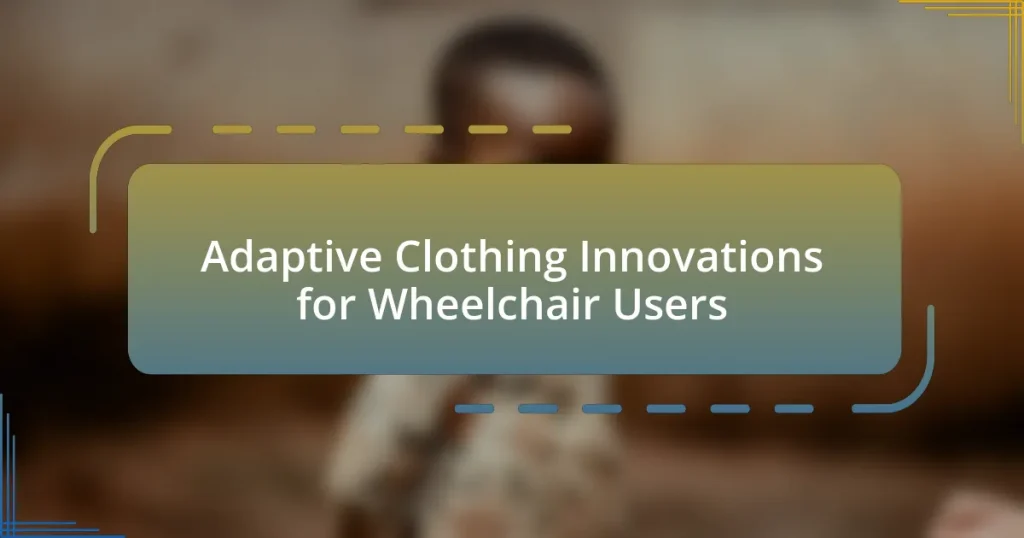Adaptive clothing innovations for wheelchair users focus on enhancing comfort, accessibility, and independence through specialized design features. These garments often include adjustable waistbands, magnetic closures, and stretchable fabrics, catering to the unique needs of individuals with mobility challenges. Research indicates that such clothing can significantly improve the quality of life by promoting self-esteem and personal expression. The article explores various adaptive clothing features, the importance of inclusivity in design, and the impact of materials and technology on usability, providing practical tips for wheelchair users to select suitable garments.

What are Adaptive Clothing Innovations for Wheelchair Users?
Adaptive clothing innovations for wheelchair users include garments designed for ease of dressing, comfort, and functionality. These innovations often feature adjustable openings, magnetic closures, and stretchable fabrics that accommodate various body types and mobility needs. For instance, brands like IZ Adaptive and Adaptive Clothing provide clothing with side openings and elastic waistbands, making it easier for users to dress independently. Additionally, research indicates that adaptive clothing can enhance the self-esteem and quality of life for individuals with disabilities by promoting greater independence and personal expression.
How do adaptive clothing innovations cater to the needs of wheelchair users?
Adaptive clothing innovations cater to the needs of wheelchair users by incorporating features that enhance comfort, accessibility, and functionality. These innovations often include adjustable waistbands, side openings, and seamless designs that accommodate sitting positions, making it easier for users to dress independently. For instance, brands like IZ Adaptive and Tommy Hilfiger have developed clothing lines specifically designed for wheelchair users, focusing on ease of wear and style. Research indicates that such adaptive clothing can significantly improve the quality of life for individuals with mobility challenges by promoting self-sufficiency and confidence in personal appearance.
What specific features make clothing adaptive for wheelchair users?
Clothing designed for wheelchair users incorporates specific features such as ease of access, comfort, and functionality. These garments often include adjustable waistbands, which allow for a better fit while seated, and strategically placed openings for easy dressing and undressing. Additionally, the use of stretchable fabrics enhances mobility and comfort, while reinforced seams provide durability against wear and tear from daily use. Research indicates that adaptive clothing can significantly improve the quality of life for wheelchair users by promoting independence and self-expression.
How do these features enhance comfort and accessibility?
Adaptive clothing innovations for wheelchair users enhance comfort and accessibility by incorporating features such as adjustable fits, breathable fabrics, and easy closures. These design elements allow for a better fit and ease of wear, which is crucial for individuals who spend extended periods in a seated position. For instance, adjustable waistbands accommodate changes in body position, while breathable materials help regulate temperature, reducing discomfort. Additionally, easy closures, such as magnetic buttons or Velcro, facilitate independent dressing, promoting autonomy. Research indicates that clothing designed specifically for wheelchair users can significantly improve their overall quality of life by addressing unique physical needs and preferences.
Why is adaptive clothing important for wheelchair users?
Adaptive clothing is important for wheelchair users because it enhances comfort, accessibility, and independence. Traditional clothing often does not accommodate the unique needs of individuals who use wheelchairs, leading to discomfort and difficulty in dressing. Adaptive clothing is designed with features such as adjustable openings, stretchable fabrics, and easy closures, which facilitate dressing and undressing without compromising style. Research indicates that appropriate clothing can significantly improve the quality of life for wheelchair users by promoting self-esteem and social participation. For instance, a study published in the Journal of Rehabilitation Research and Development highlights that adaptive clothing can reduce the physical strain associated with dressing, thereby fostering greater autonomy for individuals with mobility impairments.
What challenges do wheelchair users face with traditional clothing?
Wheelchair users face significant challenges with traditional clothing, primarily due to fit, accessibility, and comfort. Traditional garments often do not accommodate the seated position, leading to issues such as restricted movement and discomfort. For instance, clothing designed for standing individuals may bunch up or create pressure points when seated, which can cause skin irritation or pressure sores. Additionally, traditional fastenings like buttons and zippers can be difficult to manage independently, impacting the user’s ability to dress without assistance. Research indicates that adaptive clothing designed specifically for wheelchair users can alleviate these issues by incorporating features such as adjustable waistbands, side openings, and softer fabrics, enhancing both functionality and comfort.
How can adaptive clothing improve the quality of life for wheelchair users?
Adaptive clothing can significantly improve the quality of life for wheelchair users by enhancing comfort, accessibility, and independence. These garments are designed with features such as easy closures, adjustable fits, and materials that accommodate sitting positions, which help reduce discomfort and skin irritation. Research indicates that adaptive clothing can lead to increased self-esteem and social participation among individuals with disabilities, as it allows for greater expression of personal style and easier dressing. For instance, a study published in the Journal of Fashion Marketing and Management found that adaptive clothing positively impacts the psychological well-being of users by promoting a sense of normalcy and inclusion in social settings.

What types of adaptive clothing innovations exist for wheelchair users?
Adaptive clothing innovations for wheelchair users include features such as adjustable waistbands, magnetic closures, and seated-friendly designs. These innovations are specifically tailored to enhance comfort and accessibility, addressing the unique needs of individuals who use wheelchairs. For instance, adjustable waistbands allow for a better fit while seated, and magnetic closures simplify dressing for those with limited dexterity. Additionally, seated-friendly designs often incorporate longer back lengths and side openings to facilitate ease of movement and prevent discomfort. These advancements are supported by research indicating that adaptive clothing significantly improves the quality of life for wheelchair users by promoting independence and self-expression.
How do different styles of adaptive clothing serve various needs?
Different styles of adaptive clothing serve various needs by providing functional solutions tailored to the unique challenges faced by individuals with disabilities. For instance, clothing designed with magnetic closures or side zippers facilitates easier dressing for wheelchair users, enhancing independence and comfort. Additionally, moisture-wicking fabrics and breathable materials address the specific needs of individuals who may experience temperature regulation issues due to limited mobility. Research indicates that adaptive clothing can significantly improve the quality of life for users by promoting self-esteem and social inclusion, as highlighted in studies conducted by the University of Southern California, which found that accessible fashion positively impacts the mental well-being of individuals with disabilities.
What are the key categories of adaptive clothing for wheelchair users?
The key categories of adaptive clothing for wheelchair users include tops, bottoms, outerwear, and accessories. These categories are designed to accommodate the unique needs of individuals who use wheelchairs, focusing on ease of dressing, comfort, and functionality. For instance, tops may feature open-back designs for easier dressing, while bottoms often include adjustable waistbands and reinforced seams to withstand wear. Outerwear is typically designed to provide warmth without bulk, and accessories may include items like adaptive shoes and gloves that enhance usability. These innovations are essential for promoting independence and comfort for wheelchair users.
How do these categories differ in terms of functionality?
Adaptive clothing innovations for wheelchair users differ in functionality primarily through their design features tailored to enhance comfort, accessibility, and ease of use. For instance, garments may incorporate adjustable openings, magnetic closures, and stretchable fabrics to accommodate various body types and mobility needs. These functional adaptations allow users to dress independently and comfortably, addressing challenges such as limited dexterity or the need for quick changes. Research indicates that adaptive clothing significantly improves the quality of life for wheelchair users by promoting autonomy and reducing the physical strain associated with traditional clothing.
What materials are commonly used in adaptive clothing for wheelchair users?
Adaptive clothing for wheelchair users commonly utilizes materials such as cotton, spandex, polyester, and moisture-wicking fabrics. Cotton provides comfort and breathability, while spandex offers stretchability for ease of movement. Polyester is often used for its durability and resistance to wrinkles, and moisture-wicking fabrics help keep the skin dry by drawing sweat away. These materials are selected to enhance comfort, functionality, and ease of dressing for individuals with mobility challenges.
How do fabric choices impact the usability of adaptive clothing?
Fabric choices significantly impact the usability of adaptive clothing by influencing comfort, functionality, and ease of dressing. For instance, lightweight and breathable fabrics enhance comfort for wheelchair users, reducing the risk of overheating and skin irritation during prolonged wear. Additionally, stretchable materials facilitate easier movement and dressing, accommodating various body shapes and mobility challenges. Research indicates that fabrics with moisture-wicking properties can also improve user experience by keeping the skin dry, which is crucial for individuals with limited mobility who may be prone to skin issues. Therefore, selecting appropriate fabrics is essential for maximizing the effectiveness and comfort of adaptive clothing for wheelchair users.
What are the benefits of using moisture-wicking or stretchable fabrics?
Moisture-wicking and stretchable fabrics provide significant benefits for wheelchair users by enhancing comfort and mobility. Moisture-wicking fabrics draw sweat away from the skin, keeping users dry and reducing the risk of skin irritation or infections, which is crucial for individuals with limited mobility. Stretchable fabrics allow for greater freedom of movement, accommodating various body positions and reducing restrictions during daily activities. Research indicates that these fabrics can improve overall user satisfaction and comfort, making them essential in adaptive clothing design for wheelchair users.

What are the latest trends in adaptive clothing innovations for wheelchair users?
The latest trends in adaptive clothing innovations for wheelchair users include the development of garments that prioritize functionality, comfort, and style. Innovations such as magnetic closures, adjustable waistbands, and seamless designs enhance ease of dressing and undressing, catering specifically to the needs of individuals with limited mobility. Additionally, the use of moisture-wicking and stretchable fabrics improves comfort and fit, while fashion-forward designs are increasingly being integrated to promote personal expression. Research from the University of Illinois highlights that adaptive clothing can significantly improve the quality of life for wheelchair users by fostering independence and self-esteem.
How is technology influencing adaptive clothing design?
Technology is significantly influencing adaptive clothing design by enabling the creation of garments that enhance functionality, comfort, and accessibility for wheelchair users. Innovations such as 3D printing allow for customized fits that accommodate specific body shapes and needs, while smart textiles incorporate features like temperature regulation and moisture-wicking properties. Additionally, advancements in fabric technology, such as stretchable materials and magnetic closures, facilitate easier dressing and undressing, addressing the challenges faced by individuals with limited mobility. Research indicates that these technological advancements not only improve the wearability of adaptive clothing but also promote independence and self-expression among users, ultimately enhancing their quality of life.
What role do smart textiles play in adaptive clothing innovations?
Smart textiles are integral to adaptive clothing innovations as they enhance functionality and comfort for wheelchair users. These textiles can incorporate features such as temperature regulation, moisture-wicking, and stretchability, which cater specifically to the needs of individuals with mobility challenges. For instance, research has shown that smart textiles can monitor physiological parameters, providing real-time feedback that can improve user comfort and safety. Additionally, the integration of sensors within the fabric allows for the development of clothing that can adapt to various environmental conditions, thus promoting independence and improving the quality of life for wheelchair users.
How are 3D printing and customization shaping the future of adaptive clothing?
3D printing and customization are revolutionizing adaptive clothing by enabling the creation of tailored garments that meet the specific needs of individuals with disabilities. This technology allows for precise measurements and designs that accommodate unique body shapes and mobility requirements, enhancing comfort and functionality. For instance, a study published in the Journal of Fashion Technology & Textile Engineering highlights that 3D printing can produce lightweight, breathable materials that are essential for wheelchair users, improving their overall experience. Additionally, customization options empower users to select styles and features that reflect their personal preferences, fostering independence and self-expression.
What are the key considerations for designing adaptive clothing for wheelchair users?
Key considerations for designing adaptive clothing for wheelchair users include functionality, comfort, accessibility, and style. Functionality ensures that clothing accommodates the unique needs of wheelchair users, such as ease of dressing and undressing, while comfort focuses on materials that prevent skin irritation and allow for breathability. Accessibility involves designing garments that can be easily manipulated by the user or a caregiver, often incorporating features like magnetic closures or adjustable elements. Style is also important, as it allows users to express their individuality and personal taste, which can enhance their confidence and self-esteem. Research indicates that adaptive clothing can significantly improve the quality of life for individuals with mobility challenges by addressing these key areas effectively.
How can designers ensure inclusivity in adaptive clothing?
Designers can ensure inclusivity in adaptive clothing by incorporating user feedback from individuals with disabilities during the design process. Engaging with this demographic allows designers to understand specific needs, preferences, and challenges faced by wheelchair users. For instance, a study published in the Journal of Fashion Technology & Textile Engineering highlights that adaptive clothing designed with input from users leads to higher satisfaction and functionality. Additionally, employing features such as adjustable fits, easy closures, and versatile styles can enhance accessibility and comfort, making clothing more adaptable to various body types and mobility requirements.
What feedback do wheelchair users provide on adaptive clothing designs?
Wheelchair users provide feedback that emphasizes the need for adaptive clothing to prioritize comfort, accessibility, and style. Many users report that traditional clothing often fails to accommodate their unique needs, such as ease of dressing and the ability to sit comfortably for extended periods. Specific feedback highlights the importance of features like adjustable waistbands, seamless designs to prevent pressure sores, and the use of breathable fabrics. Additionally, wheelchair users express a desire for fashionable options that do not compromise functionality, indicating that adaptive clothing should reflect personal style while meeting practical requirements. This feedback is supported by studies showing that inclusive design significantly enhances the quality of life for individuals with disabilities, reinforcing the necessity for thoughtful innovation in adaptive clothing.
What practical tips can help wheelchair users choose adaptive clothing?
Wheelchair users can choose adaptive clothing by prioritizing comfort, accessibility, and functionality. Selecting garments made from stretchy, breathable fabrics allows for ease of movement and temperature regulation. Additionally, opting for clothing with adjustable features, such as Velcro or magnetic closures, enhances independence and simplifies dressing.
Furthermore, considering styles that accommodate seated positions, like longer back hems and side openings, ensures a better fit and reduces discomfort. Research indicates that adaptive clothing designed specifically for wheelchair users can significantly improve their quality of life by promoting self-expression and confidence.













